Experimental Study on Matched Particle Size and Elastic Modulus of Preformed Particle Gel for Oil Reservoirs
Abstract
:1. Introduction
2. Experimental Method
2.1. Materials
2.2. Sand-Pack-Model Displacement Experiment
2.3. Glass-Etched-Model Oil Displacement Experiment
3. Results and Analyses
3.1. Matching between PPG and Reservoir Permeability
3.2. Oil Displacement Performance of Matching PPG
4. Conclusions
- (1)
- For a given reservoir with a certain permeability, a PPG with excessively small size and elastic modulus has poor capacity to increase flow resistance and reduce water channeling. A PPG with excessively large size and elastic modulus may cause permanent plugging and irreversible impairment to the reservoirs. The larger the reservoir permeability is, the larger the best matched PPG size and elastic modulus needed are.
- (2)
- The best matched PPG size and reservoir permeability have a positive logarithmic relationship, and the correlation coefficient reaches over 98%. Microscopic visualization experiments using a glass etching model prove that a PPG of 60–80 mesh and 2–4 Pa selected according to the logarithmic relationship can increase the sweeping efficiency by as much as 55% compared with water flooding for a reservoir with a permeability of 2624 × 10−3 μm2.
Author Contributions
Funding
Institutional Review Board Statement
Informed Consent Statement
Data Availability Statement
Conflicts of Interest
References
- Kamal, M.S.; Sultan, A.S.; Almubaiyedh, U.A.; Hussein, I.A. Review on Polymer Flooding: Rheology, Adsorption, Stability, and Field Applications of Various Polymer Systems. Polym. Rev. 2015, 21, 491–530. [Google Scholar] [CrossRef]
- Wang, D.; Dong, H.; Lv, C.; Fu, X.; Nie, J. Review of Practical Experience by Polymer Flooding at Daqing. SPE Reserv. Eval. Eng. 2009, 12, 470–476. [Google Scholar] [CrossRef]
- Wu, D.; Zhou, K.; Hou, J.; An, Z.; Liu, W. Review of experimental and simulation studies of enhanced oil recovery using viscoelastic particles. J. Dispers. Sci. Technol. 2021, 42, 956–969. [Google Scholar] [CrossRef]
- Cui, X. A study on the heterogeneous combination flooding system. Acta Pet. Sin. 2011, 32, 122–126. [Google Scholar]
- Zhou, K.; Hou, J.; Sun, Q.; Guo, L.; Du, Q.; Liu, Y. Study on the flow resistance of the dispersion system of deformable preformed particle gel in porous media using lbm-dem-imb method. J. Dispers. Sci. Technol. 2019, 40, 1523–1530. [Google Scholar] [CrossRef]
- Yu, B.; Zhao, S.; Long, Y.; Bai, B.; Schuman, T. Comprehensive evaluation of a high-temperature resistant re-crosslinkable preformed particle gel for water management. Fuel 2022, 309, 122086. [Google Scholar] [CrossRef]
- Baloochestanzadeh, S.; Hassanajili, S.; Escrochi, M. Rheological properties and swelling behavior of nanocomposite preformed particle gels based on starch-graft-polyacrylamide loaded with nanosilica. Rheol. Acta 2021, 60, 571–585. [Google Scholar] [CrossRef]
- Oppong, S.A.; Mandal, M.; Ojha, K. Synthesis and optimization of bentonite enforced poly (acrylamide/co- sodium dodecylbenzensulfonate) preformed particle gels for conformance control in high salinity reservoirs. Pet. Sci. Technol. 2022, 1–18. [Google Scholar] [CrossRef]
- Zhou, B.; Kang, W.; Yang, H.; Zhu, T.; Sarsenbek, T. Preparation and properties of an acid-resistant preformed particle gel for conformance control. J. Pet. Sci. Eng. 2020, 197, 107964. [Google Scholar] [CrossRef]
- Ge, J.; Wu, H.; Song, L.; Zhang, T.; Guo, H. Preparation and evaluation of soft preformed particle gels for conformance control in carbonate reservoir. J. Pet. Sci. Eng. 2021, 205, 108774. [Google Scholar] [CrossRef]
- Malmir, P.; Hashemi, A.; Soulgani, B.S. Mechanistic study of the wettability alteration induced by preformed particle gel (ppg) in carbonate reservoirs. J. Mol. Liq. 2021, 328, 115422. [Google Scholar] [CrossRef]
- Aqcheli, F.; Salehi, M.B.; Taghikhani, V.; Pahlevani, H. Synthesis of a custom-made suspension of preformed particle gel with improved strength properties and its application in the enhancement of oil recovery in a micromodel scale. J. Pet. Sci. Eng. 2021, 207, 109108. [Google Scholar] [CrossRef]
- Imqam, A.; Wang, Z.; Bai, B.J. Preformed-Particle-Gel Transport Through Heterogeneous Void-Space Conduits. SPE J. 2017, 22, 1437–1447. [Google Scholar] [CrossRef]
- Li, J.; Jiang, Z.; Wang, Y.; Zheng, J.; Huang, G. Stability, seepage and displacement characteristics of heterogeneous branched-preformed particle gels for enhanced oil recovery. RSC Adv. 2018, 8, 4881–4889. [Google Scholar] [CrossRef] [PubMed]
- Farasat, A.; Sefti, M.V.; Sadeghnejad, S.; Saghafi, H.R. Mechanical entrapment analysis of enhanced preformed particle gels (PPGs) in mature reservoirs. J. Pet. Sci. Eng. 2017, 157, 441–450. [Google Scholar] [CrossRef]
- Saghafi, H.R. Retention characteristics of enhanced preformed particle gels (PPGs) in porous media: Conformance control implications. J. Pet. Sci. Eng. 2018, 166, 962–968. [Google Scholar] [CrossRef]
- Zhao, W.; Liu, H.; Wang, J.; Zhang, H.; Yao, C.; Wang, L.; Qi, P. Investigation of restarting pressure gradient for preformed particle gel passing through pore-throat. J. Pet. Sci. Eng. 2018, 168, 72–80. [Google Scholar] [CrossRef]
- Matias-Perez, V.; Lopez-Ramirez, S.; Arguelles-Vivas, F.J. Pressure behavior in deformable preformed particle gel during water flow: Modeling and experimental approach. Fuel 2022, 318, 123572. [Google Scholar] [CrossRef]
- Wang, J.; Liu, H.Q.; Zhang, H.L.; Sepehrnoori, K. Simulation of deformable preformed particle gel propagation in porous media. AIChE J. 2017, 63, 4628–4641. [Google Scholar] [CrossRef]
- Zhou, K.; Hou, J.; Sun, Q.; Guo, L.; Bing, S.; Du, Q. An efficient lbm-dem simulation method for suspensions of deformable preformed particle gels. Chem. Eng. Sci. 2017, 167, 288–296. [Google Scholar] [CrossRef]
- Leng, J.; Wei, M.; Bai, B. Review of transport mechanisms and numerical simulation studies of preformed particle gel for conformance control. J. Pet. Sci. Eng. 2021, 2, 109051. [Google Scholar] [CrossRef]
- Esfahlan, M.S.; Khodapanah, E.; Airezatabatabaei-Nezhad, S. Comprehensive review on the research and field application of preformed particle gel conformance control technology. J. Pet. Sci. Eng. 2021, 202, 108440. [Google Scholar] [CrossRef]
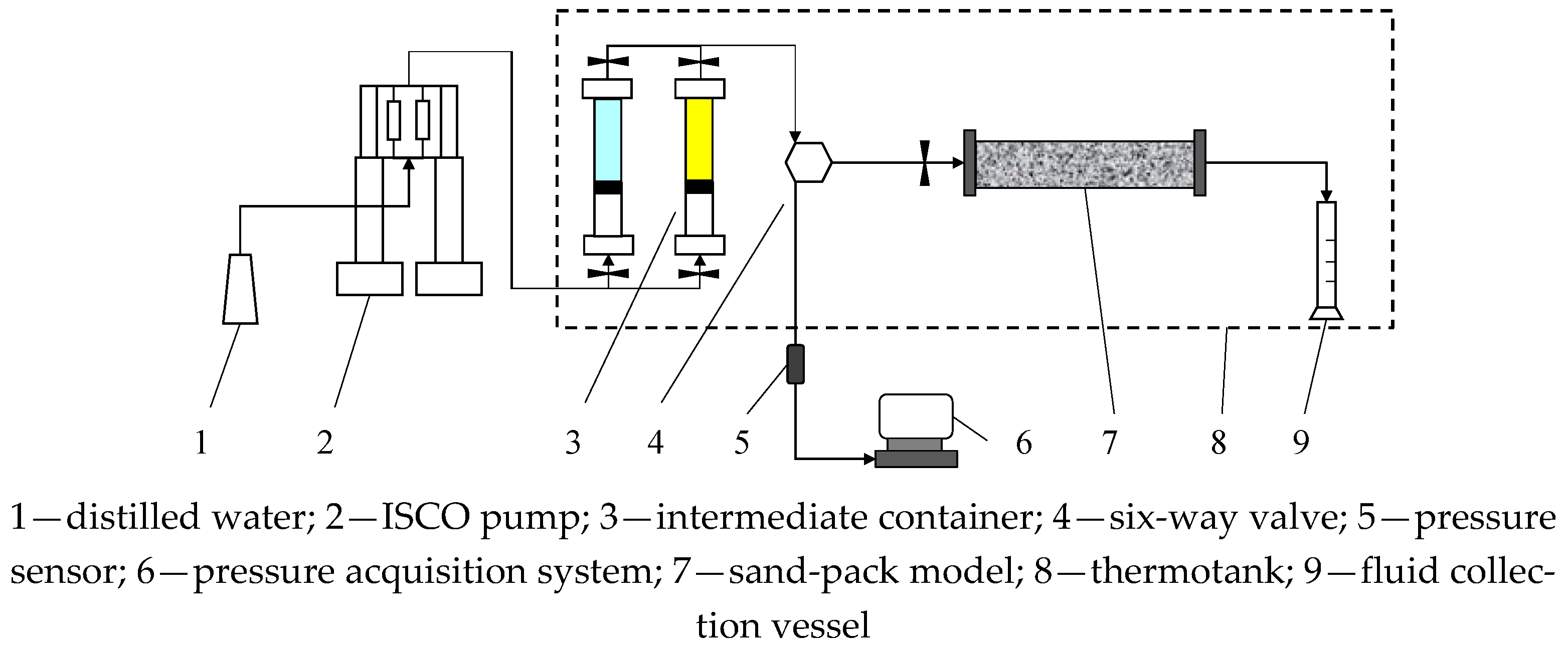
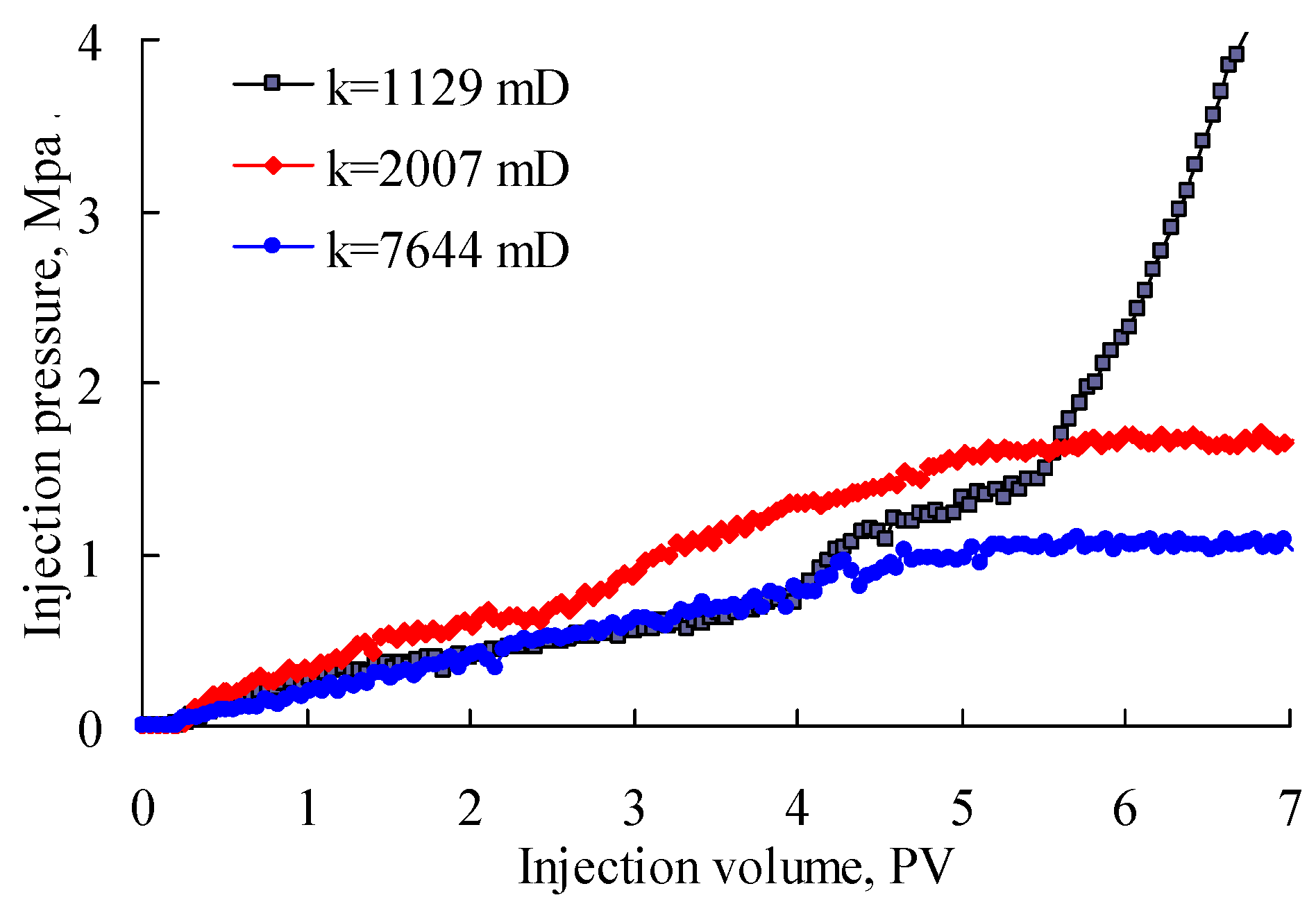

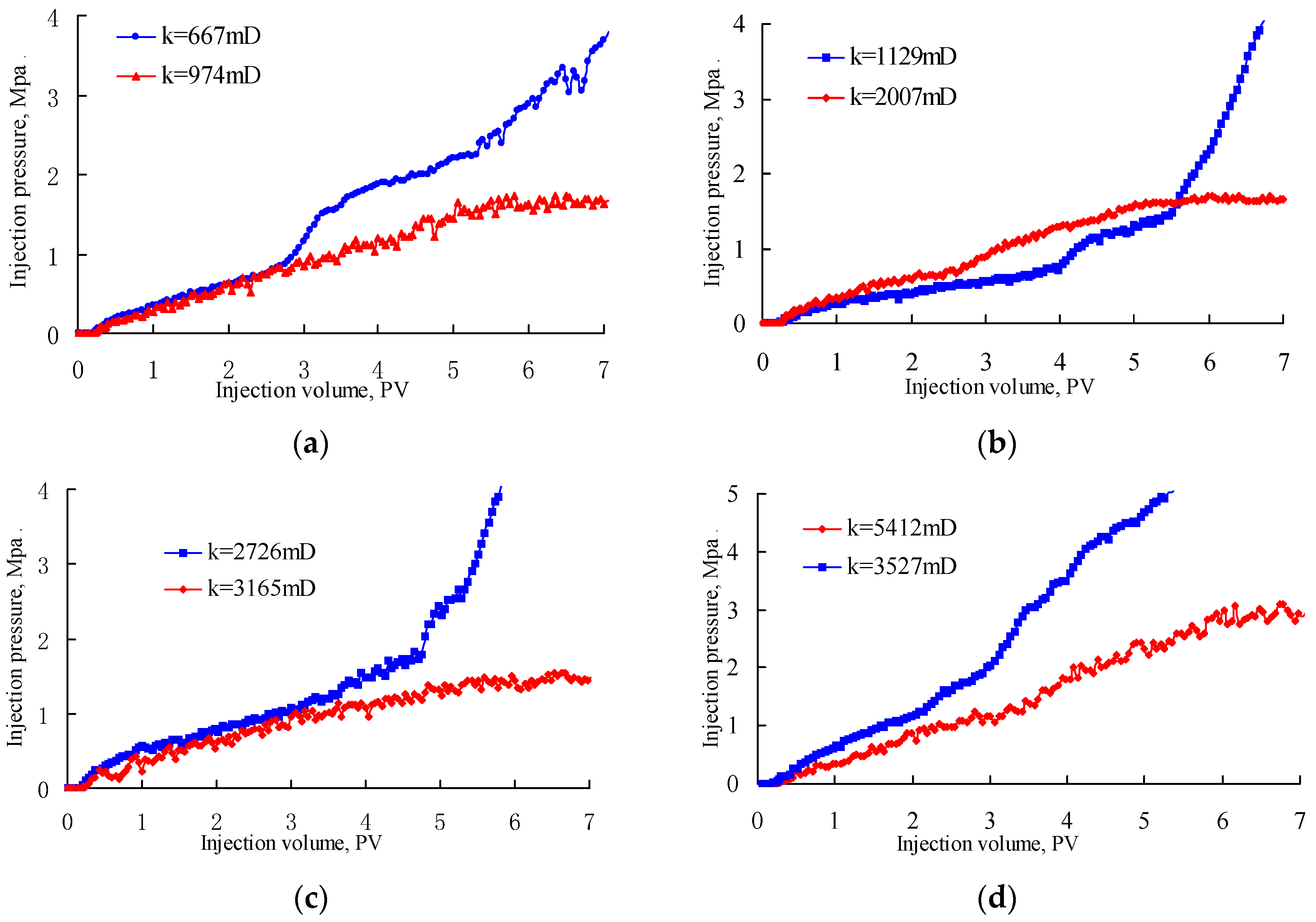
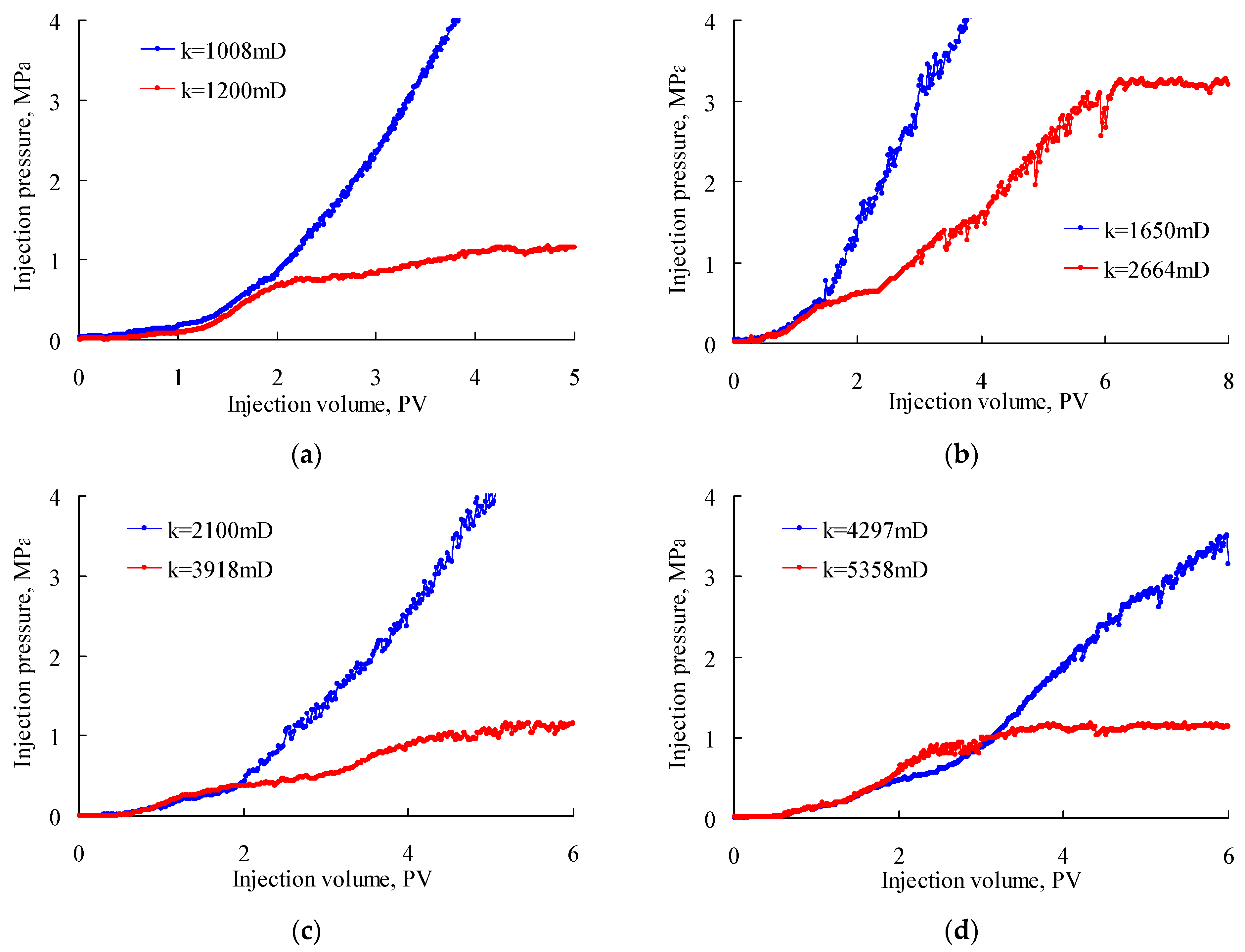
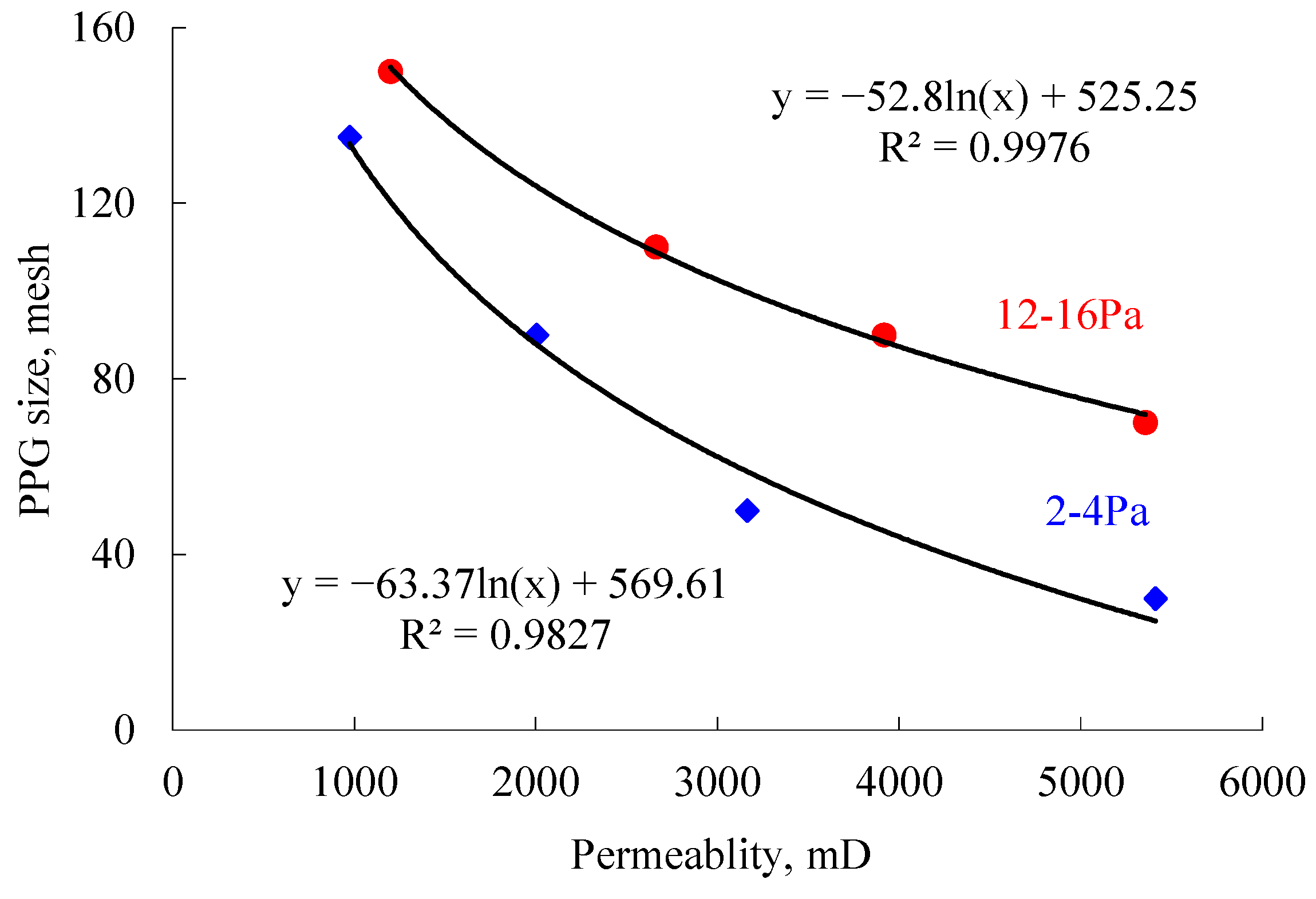
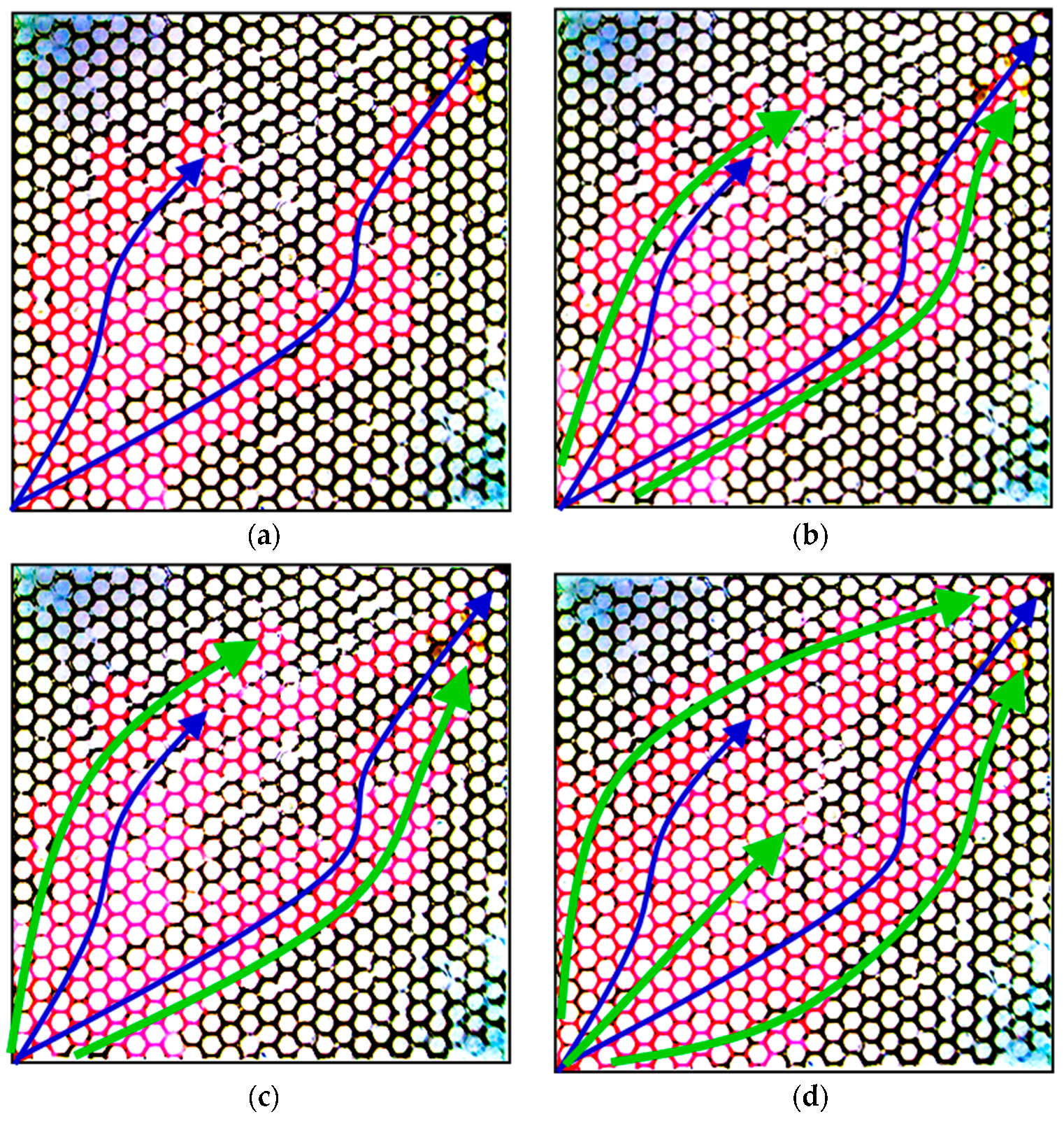

Publisher’s Note: MDPI stays neutral with regard to jurisdictional claims in published maps and institutional affiliations. |
© 2022 by the authors. Licensee MDPI, Basel, Switzerland. This article is an open access article distributed under the terms and conditions of the Creative Commons Attribution (CC BY) license (https://creativecommons.org/licenses/by/4.0/).
Share and Cite
Zhou, K.; Wu, D.; An, Z. Experimental Study on Matched Particle Size and Elastic Modulus of Preformed Particle Gel for Oil Reservoirs. Gels 2022, 8, 506. https://doi.org/10.3390/gels8080506
Zhou K, Wu D, An Z. Experimental Study on Matched Particle Size and Elastic Modulus of Preformed Particle Gel for Oil Reservoirs. Gels. 2022; 8(8):506. https://doi.org/10.3390/gels8080506
Chicago/Turabian StyleZhou, Kang, Dejun Wu, and Zhibin An. 2022. "Experimental Study on Matched Particle Size and Elastic Modulus of Preformed Particle Gel for Oil Reservoirs" Gels 8, no. 8: 506. https://doi.org/10.3390/gels8080506
APA StyleZhou, K., Wu, D., & An, Z. (2022). Experimental Study on Matched Particle Size and Elastic Modulus of Preformed Particle Gel for Oil Reservoirs. Gels, 8(8), 506. https://doi.org/10.3390/gels8080506





